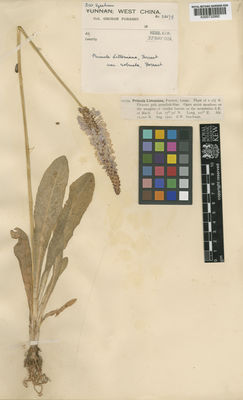-
General Description
-
Primula vialii is a striking perennial, with unusual spikes of pinkish flowers, tipped with red.
Primula vialii was found by the Scottish plant hunter George Forrest (1873-1932), and was named P. littoniana after his friend, Consul G. Litton of Tengyueh (on the Burma-China frontier), who had provided considerable help in his travels in the locality. Aleister Crowley (1875-1947), the eccentric English writer on mystic and occult subjects, also travelling in China, reported meeting 'a botanist named George Forrest' and described how, when the unfortunate Litton fell ill, 'Forrest and I galloped furiously into the darkness' to get a doctor. Sadly, it was too late, and Litton subsequently died. The name P. littoniana is now relegated to a synonym, as the plant had in fact already been named P. vialii by another plant hunter, the French missionary botanist Père Delavay.
-
Species Profile
-
Geography and distribution
Native to China (north and northwest Yunnan and southwest Sichuan), where it is found growing in wet meadows, near water in valleys, and in thickets of prickly oak bushes, from 2,800 to 4,000 m above sea level.
Description
Primula vialii has stout stems up to 60 cm tall, topped with spires of numerous, tiny, pinkish-purple flowers, which are red at the top of the spike when in bud. The flowers open from June to August. The leaves are erect, spear-shaped, softly hairy, and up to 30 cm long. Propagation is by seed.
Uses
Primula vialii is grown as an ornamental for its unusual spikes of pinkish flowers, tipped with red.
Millennium Seed Bank: Seed storage
Kew's Millennium Seed Bank Partnership aims to save plant life world wide, focusing on plants under threat and those of most use in the future. Seeds are dried, packaged and stored at a sub-zero temperature in our seed bank vault.
Number of seed collections stored in the Millennium Seed Bank: Two
Germination testing: 100% germination was achieved on a germination medium of 1% agar, at a temperature of 21°C, and a cycle of 12 hours of daylight / 12 hours of darkness
Cultivation
Primula vialii is easily grown from seed in fertile, reasonably moist but well-drained soils in a cool position. It can be grown in partial shade in woodland gardens and does especially well alongside streams or ponds, but can also be grown in open sites providing the soil is moist. The Royal Horticultural Society has given it their Award of Garden Merit (AGM).
This species at Kew
Primula vialii can be seen growing in the Rock Garden at Kew. Pressed and dried specimens are held in Kew's Herbarium, where they are available to researchers by appointment.
-
Distribution
-
China
-
Ecology
-
Wet meadows and sparse woodland.
-
Conservation
-
Not evaluated according to IUCN Red List criteria, but not considered to be at risk in the wild.
-
Hazards
-
Avoided by grazing animals, but no known hazards to humans.






